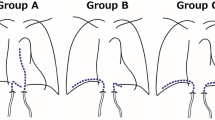Abstract
To date, despite improvement in survival rate following a Fontan operation, postoperative prolonged pleural effusion (PPE) has still remained a confounding complication of this procedure, which significantly contributes to morbidity and prolonged hospitalization. Our study aims to investigate risk factors associated with PPE after the extracardiac Fontan operation. From August 2012 to December 2019, we obtained clinical data from the medical records of 145 consecutive patients who were diagnosed with single-ventricle lesions and received an extracardiac Fontan operation at the E Hospital (Hanoi, Vietnam). PPE was defined as the need for a chest tube for > 14 days. Patients were divided into two groups, those with PPE (n = 29, 20.00%) and those without PPE (n = 116, 80.00%). During the pre-Fontan evaluation, significant differences between two groups were observed in PPE (p = 0.00), chylothorax (p = 0.045), pleurodesis (p = 0.045), position of thoracic and abdominal organs (p = 0.018), atrioventricular (AV) valve regurgitation (p = 0.030), and large aortapulmonary circulation (p = 0.041). During the Fontan evaluation, significant differences among two groups were seen in aortic cross-clamp time (p = 0.04), cardiopulmonary bypass time (p = 0.014), and mean pulmonary artery pressure (PAP) at Fontan (p = 0.0072). In multivariable analysis with logistic regression, a reduced model including independent predictors for PPE was found to be the NYHA class III (OR 4.93, 95% CI 1.19–20.50, p = 0.028), double-outlet right ventricle (DORV) with transposition of great arteries (TGA) (OR 31.00, 95% CI 1.35–711.63, p = 0.032), AV valve regurgitation (OR 70.73, 95% CI 3.28–1523.28, p = 0.007), ventricle-to-pulmonary artery shunt (OR 8.29, 95% CI 1.60–42.78, p = 0.012), PAI (OR 0.98, 95% CI 0.97–0.99, p = 0.002) at pre-Fontan, while, at Fontan, high PAP (OR 1.24, 95% CI 1.01–1.53, p = 0.046) was an independent predictor for PPE. In conclusion, the incidence of PPE was relatively low. The NYHA class III, primary anatomical diagnosis of DORV with TGA, pre-Fontan AV valve regurgitation, the existence of pre-Fontan ventricle-to-pulmonary artery shunt, low pulmonary artery index (PAI), and high PAP in the operation were identified as independent risk factors to predict PPE following a Fontan operation. As prior studies also investigated various risk factors influencing PPE, a preventive strategy that targets these factors combined with previous identified other risk factors might reduce the PPE incidence.
Similar content being viewed by others
References
Gaynor JW et al (2002) Predictors of outcome after the Fontan operation: is hypoplastic left heart syndrome still a risk factor? J Thorac Cardiovasc Surg 123(2):237–245
Lee JR et al (2003) Surgical results of patients with a functional single ventricle. Eur J Cardiothorac Surg 24(5):716–722
Murphy MO et al (2014) Management of early Fontan failure: a single-institution experience. Eur J Cardiothorac Surg 46(3):458–464
Ono M et al (2019) Predicted clinical factors associated with the intensive care unit length of stay after total cavopulmonary connection. J Thorac Cardiovasc Surg 157(5):2005–2013
McGuirk SP et al (2003) The impact of ventricular morphology on midterm outcome following completion total cavopulmonary connection. Eur J Cardiothorac Surg 24(1):37–46
Sunstrom RE et al (2015) A defined management strategy improves early outcomes after the Fontan procedure: the Portland protocol. Ann Thorac Surg 99(1):148–155
Pike NA et al (2015) Reduced pleural drainage, length of stay, and readmissions using a modified Fontan management protocol. J Thorac Cardiovasc Surg 150(3):481–487
Corda R (2015) Reducing Fontan effusions: a day saved is a dollar earned. J Thorac Cardiovasc Surg 150(3):488
Gupta A et al (2004) Risk factors for persistent pleural effusions after the extracardiac Fontan procedure. J Thorac Cardiovasc Surg 127(6):1664–1669
Fu S, Feng Z-C, Dietmar S (2010) Factors influencing pleural effusion after Fontan operation: an analysis with 95 patients. Chin Med Sci J 25(1):38–43
Kim G et al (2019) Risk factors for prolonged pleural effusion after extracardiac Fontan operation. Pediatr Cardiol 40(8):1545–1552
Allen HD et al (2013) Moss & Adams' heart disease in infants, children, and adolescents: including the fetus and young adult. Lippincott Williams & Wilkins, Philadelphia
Kaulitz R et al (1996) Modified Fontan operation in functionally univentricular hearts: preoperative risk factors and intermediate results. J Thorac Cardiovasc Surg 112(3):658–664
Cazzaniga M et al (2002) Operación modificada de Fontan o variantes efectuadas en un solo tiempo quirúrgico. Determinantes de la mortalidad. Rev Esp Cardiol 55(4):391–412
Tweddell JS et al (2009) Fontan palliation in the modern era: factors impacting mortality and morbidity. Ann Thorac Surg 88(4):1291–1299
Fu S et al (2009) Fontan extracardiac tunnel connection: fenestration or not? Chin Med J 122(19):2335–2338
Jacobs ML, Norwood WI Jr (1994) Fontan operation: influence of modifications on morbidity and mortality. Ann Thorac Surg 58(4):945–952
Bridges ND et al (1992) Effect of baffle fenestration on outcome of the modified Fontan operation. Circulation 86(6):1762–1769
Lemler MS et al (2002) Fenestration improves clinical outcome of the Fontan procedure: a prospective, randomized study. Circulation 105(2):207–212
Funding
None.
Author information
Authors and Affiliations
Corresponding author
Ethics declarations
Conflict of interest
The authors declare that they have no conflicts of interest.
Ethical Approval
All procedures performed in studies involving human participants were in accordance with the ethical standards of the institutional and/or national research committee and with the 1964 Helsinki declaration and its later amendments or comparable ethical standards. This study was approved by the Ethics Board of the Hanoi Medical University.
Informed Consent
Informed consents were obtained from all individual participants included in the study.
Additional information
Publisher's Note
Springer Nature remains neutral with regard to jurisdictional claims in published maps and institutional affiliations.
Rights and permissions
About this article
Cite this article
Tran, D.D., Le, T.N., Dang, V.H.T. et al. Predictors of Prolonged Pleural Effusion After the Extracardiac Fontan Procedure: A 8-Year Single-Center Experience in Resource-Scare Setting. Pediatr Cardiol 42, 89–99 (2021). https://doi.org/10.1007/s00246-020-02457-1
Received:
Accepted:
Published:
Issue Date:
DOI: https://doi.org/10.1007/s00246-020-02457-1



